Purple, traditionally associated with royalty, certainly is a rich colour in the garden. As a fan of the colour purple, I started taking photographs of purple flowers in the garden and I share some of them here.
It is surprising how many purple flowers there are. All the plants pictured in this post are indigenous to South Africa, except for one, which occurs naturally in Zimbabwe and Mozambique and further north into tropical Africa. Despite not being a salvia, it is commonly known as the Giant Salvia (Brillantaisia subulugurica or Brillantaisia cicatricosa ) and is a tall understorey plant found usually at the margins of evergreen forests. It has become a popular garden plant.
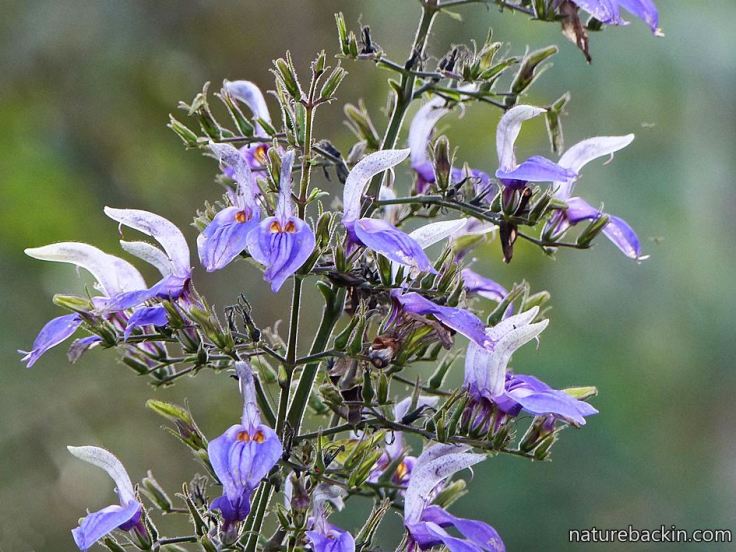
Although they are purple, in this photo, the flowers of the Giant Salvia have a bluish tinge. The flowers are shaped so as to deposit pollen on the backs of the large carpenter bees that are frequent visitors to this plant
As I recall from my junior school history lessons, in ancient times the Phoenicians used to make purple dye from molluscs found in the Mediterranean near the city or Tyre. Checking now, this remnant memory from school history is true. Using a complex process, based on mucus extracted from the bodies of sea molluscs, the dye was produced in a very smelly process using thousands of tiny snails to produce just one ounce of dye. Named Tyrian purple (after the city of Tyre) dye was produced in this way as far back as the 15th century BC. The dye was so expensive to produce that only the very rich and powerful could afford it – hence its association with royalty.
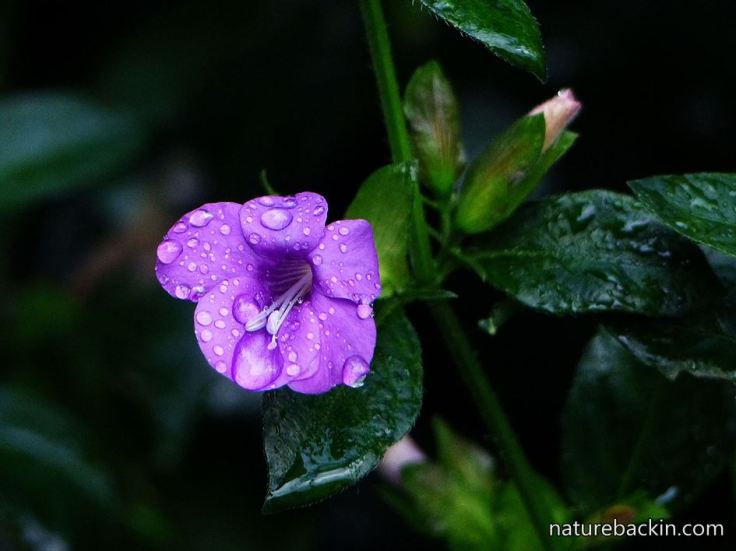
This photo reflects the true purple of the Bush Violet (Barleria obtusa, although it might be the Barleria repens), a plant that sprawls, scrambles or cascades, covered in these lovely flowers in late summer through to autumn
Returning to the history of purple dye in Europe, during the Byzantine Empire rulers wore Imperial purple, but during the Middle Ages after the fall of Constantinople when the dye from Byzantium could no longer be imported, the Pope decreed that cardinals should wear scarlet attire, dyed using kermes dye, obtained from the bodies of a specific scale insect. Lower-ranking clerics such as bishops made do with garments coloured using a less expensive process, with cloth dyed first with indigo and then overdyed using smaller amount of the expensive kermes dye.
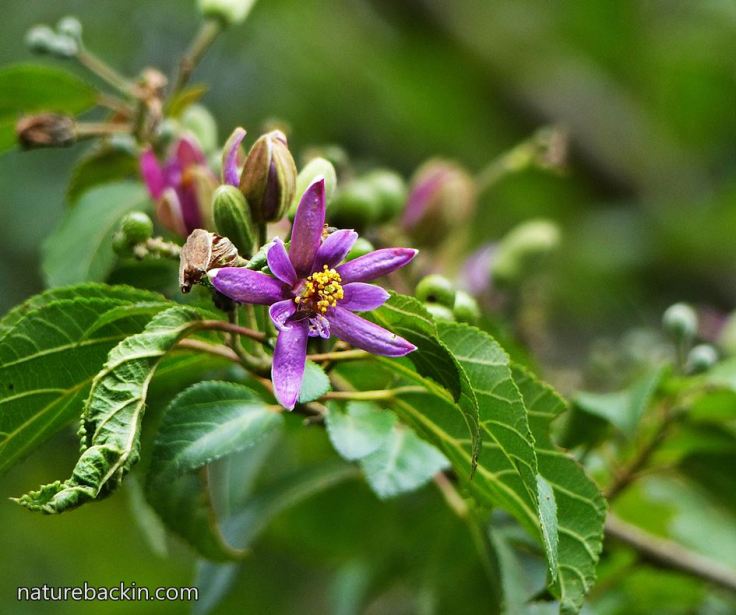
The purple flower of the Cross-berry (Grewia occidentalis) a shrubby or single-stemmed tree, a host of the processional caterpillar in our garden, as well as a provider of small berries favoured by birds and vervet monkeys
In reading about the colour purple, I was fascinated to learn that a commercially viable purple dye was discovered quite by accident in England by a young chemistry student, William Henry Perkin, in 1856 (when he was only 18 years old), when he was trying to make a synthetic quinine as a treatment for malaria. What he did find was that this synthetic compound made a rather good purple dye, and he cannily patented it and developed an industrial process to make an affordable dye that came to have the name “mauve”, derived from the name for the purple mallow flower. Purple then became affordable to almost everyone, including artists and suffragettes, gaining an association with counter-cultures right through to the hippies of the 1960s and beyond.
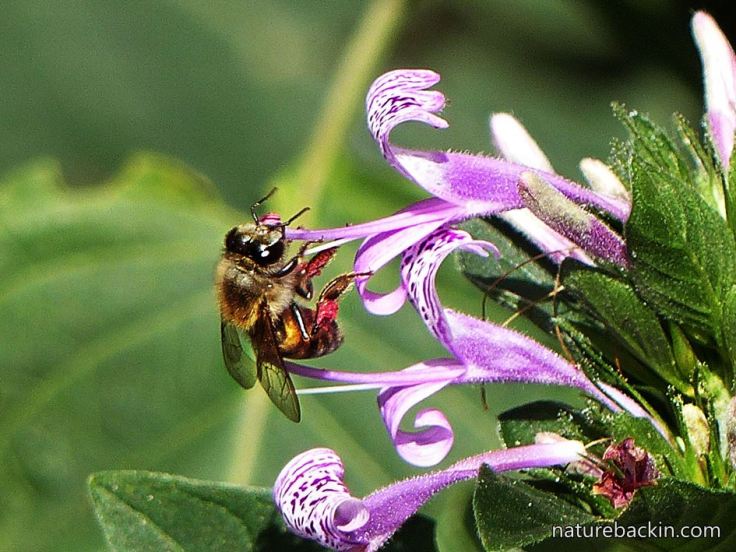
The purple and cream flowers of the Ribbon Bush (named because the petals curl like florist’s ribbon) attract many pollinators, including honey bees. As can be seen in the photos, even the pollen in the sacs on the hind-legs of the bees is purple! The Ribbon Bush (Hypoestes aristata) flowers in early winter and brightens up parts of the garden that are starting to look dusty and arid. After flowering, plants self-seed readily, and we prune it back after it has had a chance to seed
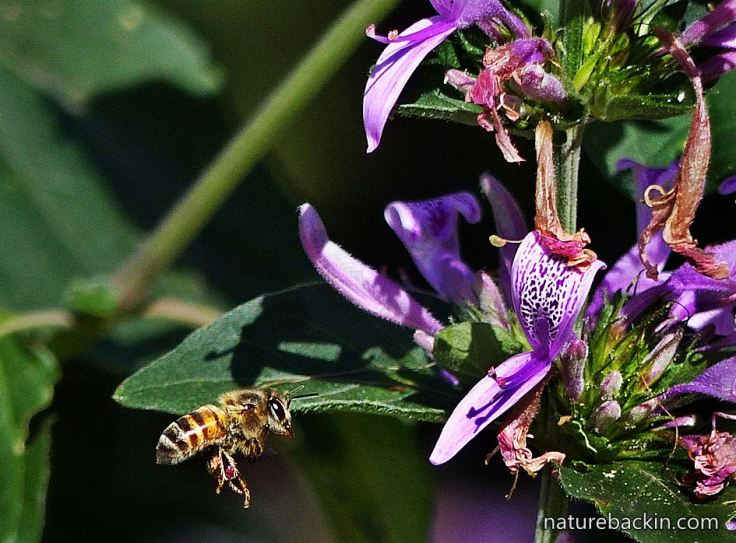
It seems that some pollinators may be attracted to a certain range of colours only, and although many pollinators are attracted to a wide range of colours, planting a diversity of flowering plants with a diversity of colours and flowering times, means that most pollinators will be catered for and at different times of the year.
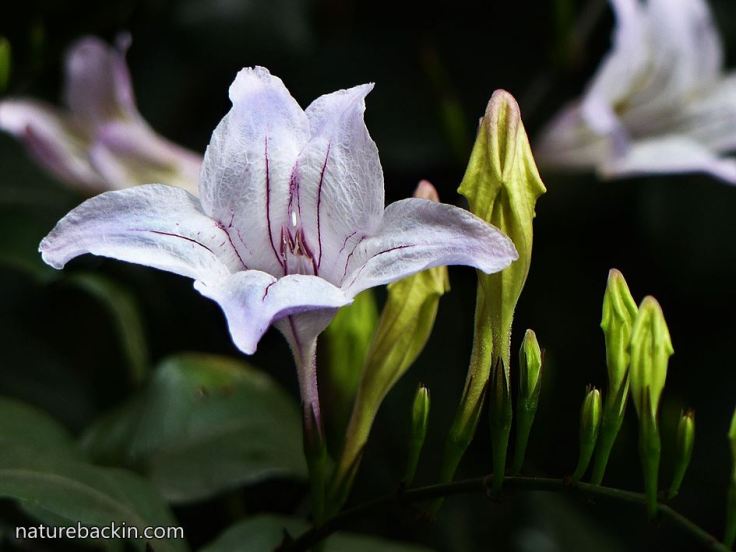
The Mackaya bella (also known as the Forest Bell Bush) is a favourite of mine, doing well in shady areas and flowering in summer. The mauvish-to-white flowers are delicately veined in purple. According to Pitta Joffe, when viewed under ultra-violet light, the flowers can be seen to have “landing lights” that guide pollinators, such as carpenter bees, to the nectar in the centre of the flower
Historically, purple pigments and dyes, or combinations of red and blue pigments and dyes, were used across the world, but the Tyrian dye was unusual in that it did not fade. The first synthetic purple dyes also had a problem with fading and it was only in the 19th and 20th century that synthetic dyes that did not fade were developed.
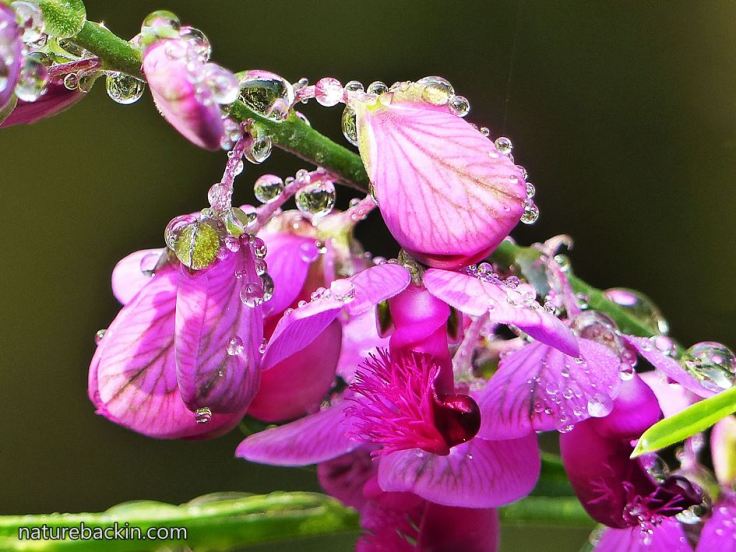
The free flowering Purple Broom (Polygala virgata) is a grassland plant, also occurring in forest margins. When young the flowers have a pinker tone, as in the photo above of flowers bedecked with rain drops. In the photo below, the more mature flowers are a true purple colour
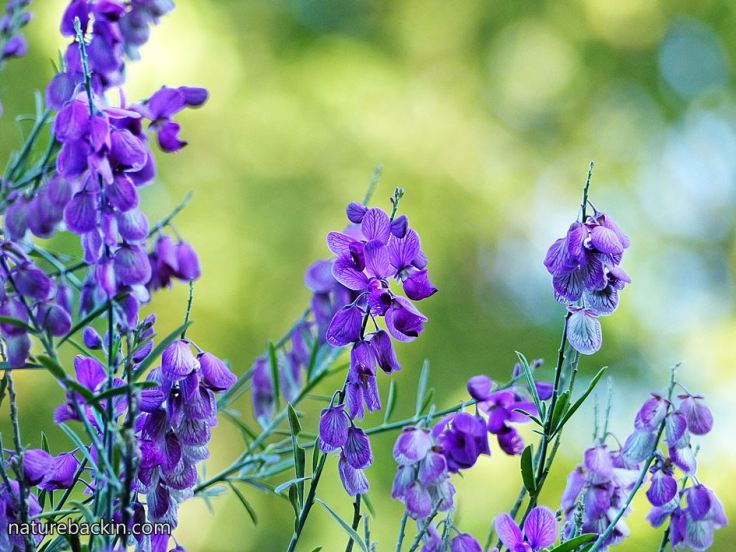
Of course it is not just flowers that are purple in the garden. We have several indigenous plants that bear purple berries, and in the vegetable garden we currently have a crop of peas with purple pods (though the peas are green) in addition to the pansies and lavender. Also, several species of birds with purple feathers are regular visitors. But for now, I’ll stick with flowers. It might just be possible to get purple overload?
Sources: Joffe, Pitta. 2001. Creative Gardening with Indigenous Plants: A South African Guide. Pretoria: Briza; Melina, R. 2011. Why is the color purple associated with royalty? Live Science. https://www.livescience.com/33324-purple-royal-color.html; Purple https://en.wikipedia.org/wiki/Purple
Posted by Carol









September 15, 2017 at 2:20 am
Beautiful captures!
LikeLike
September 15, 2017 at 5:59 am
Thanks so much LeAnn.
LikeLiked by 1 person
August 10, 2017 at 1:14 am
Purple is such a rich color. I loved it as a child, outgrew it, and now am back in love with it again. I especially like the purples that are almost blue, like the flowers of the Giant Salvia. What a beautiful plant! Thank you for your enlightening essay!
LikeLiked by 1 person
August 11, 2017 at 5:48 am
Thanks very much. There is something special about purple!
LikeLike
August 9, 2017 at 7:10 pm
A fascinating account of essence of the the history of the sources of the colour purple, beautifully supported with those lovely flower images and I love the bee carrying purple pollen! In holistic therapies purple, or violet is also the colour associated with the crown chakra, healing and intuition.
LikeLiked by 1 person
August 9, 2017 at 9:07 pm
Thanks. I was impressed by the purple pollen too!
LikeLiked by 1 person
August 4, 2017 at 8:09 am
My nickname for many years was Murasaki short for Murasaki No Hana Murasaki Shishibo was the mother of novel writing in 11th century Japan… Her best known work is The Tale of Genji. Murasaki No Hana means ‘purple flower’ and the nickname was a result of my love of purple flowers. A love that stays to this day. Thank you… this post has filled me brimfull with pleasure 💛
LikeLiked by 1 person
August 4, 2017 at 9:31 am
This is beautiful Osyth, and makes me smile too. I read that in China and Japan purples dyes were made from the roots of a plant with purple flowers, but that the lovely colour faded easily, perhaps making it paradoxically even more valuable? Interesting that purple’s associations with nobility and spirituality cross many cultures.
LikeLike
August 4, 2017 at 7:15 am
I loved the history lesson. But I also admire these photos, because it seems (though not knowing most of these plants, I can’t be sure) that you’ve managed to stay true to their colours. I’ve always found natural blues and purples very tricky indeed to photograph.
LikeLiked by 1 person
August 4, 2017 at 9:19 am
Thanks so much Margaret. So true about blue and purple not being easy to replicate accurately in photos, but these (apart from the Giant Salvia) are reasonably close. I found the history of purple dyes and pigments so fascinating I struggled not to include more! Even purple’s place in the colour spectrum is interesting though rather technical. Fortunately I managed to resist going off on yet another tangent 🙂
LikeLiked by 1 person
August 4, 2017 at 1:42 am
Interesting history of dyes – i do love the color purple!
LikeLiked by 1 person
August 4, 2017 at 4:32 am
Thanks Eliza. Nice to know that you love purple too.
LikeLike
August 3, 2017 at 11:46 pm
Excellent post! Informative and beautifully photographed.
LikeLiked by 1 person
August 4, 2017 at 4:31 am
Thanks very much Belinda.
LikeLiked by 1 person